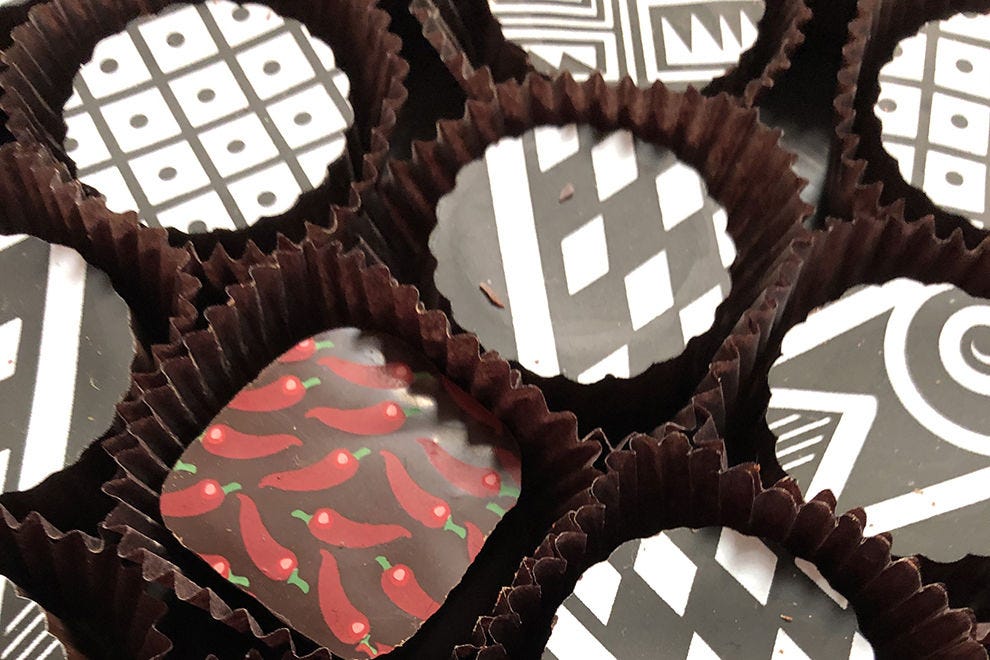The tradition of cacao has endured in the region for more than a thousand years
 |
| Kakawa Chocolate House in Santa Fe makes traditional chocolate elixirs, as well as such treats as chocolate-dipped chile de árbol — Photo courtesy of Kakawa Chocolate House |
Today, cacao is a staple of Valentine’s Day chocolates, but the food is hardly a modern marvel. Indigenous peoples were consuming cacao in what is now the American Southwest more than a thousand years ago, long before it was shaped into truffles and packaged in heart-shaped boxes.
University of New Mexico archeology professor Dr. Patricia Crown led a team of researchers to two ground-breaking discoveries that placed chocolate in the Southwest centuries before it was thought to have arrived in the region.
Previously, the Spanish were thought to have carted it into the area in the 15th century. Crown and her team — which included W. Jeffrey Hurst, formerly of the Hershey Technical Center in Hershey, Pennsylvania — found that the Hohokam peoples consumed cacao in what is now Arizona between 750 and 900 A.D.
Crown also traced chocolate consumption to today’s Chaco Culture National Historical Park, in western New Mexico, to around 900 and 1100 A.D. To discover this connection, the team looked for biomarkers for specific substances in centuries-old ceramics. They found residue of theobromine: a telltale chemical in cacao.
 Art of Chocolate / Cacao Santa Fe creates chocolate truffles with pottery-inspired designs — Photo courtesy of Art of Chocolate / Cacao Santa Fe
Art of Chocolate / Cacao Santa Fe creates chocolate truffles with pottery-inspired designs — Photo courtesy of Art of Chocolate / Cacao Santa Fe
Because cacao can’t grow in the arid southwest, Crown says these discoveries point to trade between the ancient peoples who resided there and Mesoamerica. “It had to come from the tropics. It was a trade item,” she explains. “If you’re going to use it in ritual activity, which is what we think they were doing, you’d have to establish an ongoing supply.”
Crown believes the cacao was consumed as drinking chocolate, similar to how the Aztecs and Maya consumed it. These ancient civilizations have an even longer history of consuming the plant. Their drinking chocolate wasn’t the milky, hot chocolate popular today; cacao powders were dissolved into water, making for a complex, potent elixir.
At Chaco, the team discovered cacao in cylindrical pottery jars made in pairs with lids of sandstone discs. “Hard chocolate, like candy bars, is a relatively recent invention. In the past, cacao was consumed by drinking it or in sauces, like moles,” she says. “Throughout Mesoamerica, the froth was considered the most delicious part. At Chaco, we believe they created froth by pouring the chocolate back and forth between cylindrical jars. That’s why they were made in sets of two to four jars.”
More than a thousand years after cacao’s arrival in the American Southwest, several chocolate shops in Arizona and New Mexico are continuing to tap into these traditions and regional flavors.
 Monsoon Chocolate creates truffles sourced from local ingredients — Photo courtesy of Monsoon Chocolate / Julius Schlosburg
Monsoon Chocolate creates truffles sourced from local ingredients — Photo courtesy of Monsoon Chocolate / Julius Schlosburg
Located in Santa Fe, New Mexico, Kakawa Chocolate House and Art of Chocolate/Cacao Santa Fe both serve chocolate elixirs. Kakawa celebrates historic European elixirs as well as more traditional Mesoamerican elixirs. Using archeological research and accounts by Spanish settlers, the intimate chocolate house has recreated recipes using ground cacao beans, spices, chile, and herbs.
The Art of Chocolate/Cacao Santa Fe too blends drinking chocolates and elixirs. Historical documents also inspire their recipes, which use unsweetened chocolate that begins in bean form and is roasted and ground in-house. The Zapotec Tejate incorporates ground blue corn, which the indigenous peoples of the Southwest have long cultivated. The Tolteca Notchli is sweetened with prickly pear cactus juice (another local ingredient) and chile powder.
Although they specialize in hardened chocolate bars that the peoples of the ancient Southwest wouldn’t recognize, the bean-to-bar makers at Taos, New Mexico's Chokolá celebrate the “food of the gods.” The craft chocolaterie specializes in single-origin chocolate bars, truffles and mousses. Often its chocolate originates in Central and South America.
In Arizona, Tucson chocolate maker and confectioner Monsoon Chocolate creates truffles utilizing regional flavors — some that may have even been present when the Hohokam were first consuming cacao more than a thousand years ago. For example, the Chiltepin truffle uses dark-chocolate ganache infused with chiltepin pepper: the wild chile pepper native to the Southwest consumed by indigenous peoples. The Sonoran Sea Salt Dark Chocolate truffle is garnished with Tohono O’odham salt from the Sonoran flats at the Gulf of California.
Monsoon Chocolate also draws from more modern inspirations, such as in the Whiskey del Bac Dorado truffle, which layers caramel and chocolate. The chocolate makers infuse both elements with mesquite-smoked whiskey from Tucson spirit-maker Hamilton Distillers. Though it’s a contemporary creation, it’s still imbued with the tastes of the desert where America’s obsession with chocolate first began.
All of the chocolate artisans discussed here – Kakawa Chocolate House, The Art of Chocolate/Cacao Santa Fe, Chokolá, and Monsoon Chocolate – ship at least some of their confections through their websites. As of this writing, many of them also offer local delivery or curbside pickup as well.

No comments:
Post a Comment